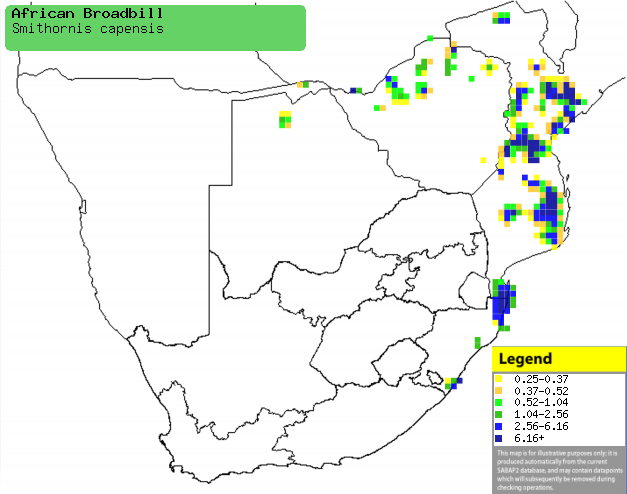|
Smithornis capensis (African
broadbill)
BreŽbek [Afrikaans]; Kaapse breedbek [Dutch];
Eurylaime du Cap [French]; Kap-Breitrachen [German]; Bocarra-africana
[Portuguese]
Life
> Eukaryotes >
Opisthokonta
> Metazoa (animals) >
Bilateria >
Deuterostomia > Chordata >
Craniata > Vertebrata (vertebrates) > Gnathostomata (jawed
vertebrates) > Teleostomi (teleost fish) > Osteichthyes (bony fish) > Class:
Sarcopterygii (lobe-finned
fish) > Stegocephalia (terrestrial
vertebrates) > Tetrapoda
(four-legged vertebrates) > Reptiliomorpha > Amniota >
Reptilia (reptiles) >
Romeriida > Diapsida > Archosauromorpha > Archosauria >
Dinosauria
(dinosaurs) > Saurischia > Theropoda (bipedal predatory dinosaurs) >
Coelurosauria > Maniraptora > Aves
(birds) >
Order: Passeriformes
The African broadbill mainly occurs in south-central and
southern Africa, where it has populations scattered across northern Zimbabwe and
Botswana, Mozambique and KwaZulu-Natal. It is locally common although difficult
to see, as it is extremely inconspicuous, remaining motionless on its perch for
long periods. It generally prefers dense forest or woodland, exclusively eating
invertebrates, such as grasshoppers, beetles and spiders. Both sexes construct
an oval-shaped nest, which is suspended conspicuously from a low branch of a
tree.
Distribution and habitat
It has two separate populations: one in
coastal West Africa and the other, larger one in the area from Uganda to
southern Africa. Here it occurs in small areas of northern Zimbabwe and
Botswana, Mozambique and KwaZulu-Natal. It is locally common although difficult
to see, as it is extremely inconspicuous, remaining motionless on its perch for
long periods. It usually occupies coastal evergreen or lowland forest, deciduous
thickets or dense woodland.
|
 |
|
Distribution of African broadbill in southern Africa,
based on statistical smoothing of the records from first SA Bird Atlas
Project (©
Animal Demography unit, University of
Cape Town; smoothing by Birgit Erni and Francesca Little). Colours range
from dark blue (most common) through to yellow (least common).
See here for the latest distribution
from the SABAP2. |
Food
It exclusively eats invertebrates,
foraging on the ground, in trees and occasionally in flight. The following food
items have been recorded in its diet:
Breeding
- Both sexes build the nest, which is an oval-shaped structure with a side
entrance, made of bark, dry leaves, twigs, grass and rootlets, often held
together by strands of spider web. It is not concealed, in fact hangs
conspicuously from a low branch of a tree, usually about 1.5-3.0 m above
ground.
- Laying dates vary from country to country, however egg-laying season is
usually from October-January.
- It lays 1-3 eggs, which are incubated solely by the female for about
16-17 days, while the male keeps watch outside, signalling danger with a
high-pitched call.
- Little is known about the development and care of the young, except that
they are fed mainly by the male.
Threats
Not threatened globally, however it has been badly affected
by deforestation in southern Mozambique and KwaZulu-Natal.
References
-
Hockey PAR, Dean WRJ and Ryan PG 2005. Roberts
- Birds of southern Africa, VIIth ed. The Trustees of the John Voelcker
Bird Book Fund, Cape Town.
|
